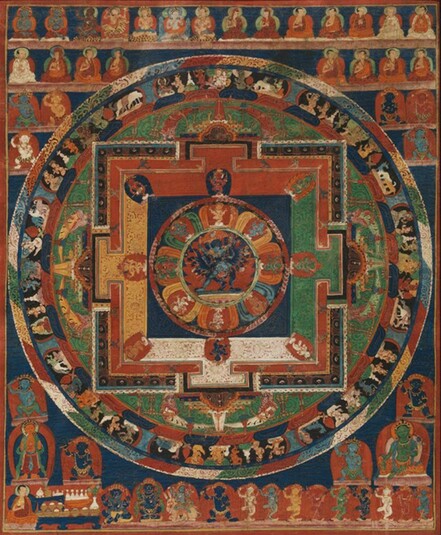
Item: Mandala of Hevajra (Buddhist Deity) - (Samputa Tantra)
| Origin Location | Tibet |
|---|---|
| Date Range | 1500 - 1599 |
| Lineages | Sakya and Buddhist |
| Material | Ground: Cotton |
| Collection | Private |
| Catalogue # | Collection of Nancy Wiener Gallery |
Hevajra, Shastradhara Mandala. This particular form of Hevajra holds various weapons in the hands and is described in the Samputa Tantra, an explanatory Tantra for both the Hevajra and Chakrasamvara systems of practice.
Sanskrit: Hevajra Tibetan: Gye pa dor je
Tibetan: Gye pa dor je
The lineage of teachers in the top registers are read from left to right and begin with Vajradhara, Nairatmya, Virupa, Dombi Heruka, etc.
At the upper right and left of the circular mandala 'corners' are the Great Wrathful Ones: Ushnisha Chakravartin (yellow), Yamantaka (blue), Humkara (blue), Prajnantaka (white), Padmantaka (red), Vighnantaka (blue), Achala (blue), Takkiraja (blue), Niladanda (Blue), Mahabala (blue), Shumbharaja (blue). This last figure 'Shumbharaja' is located at the center of the bottom register.
At the lower left corner is a standing figure with one face and two hands holding a vase, orange in colour. This is possibly a standing form of Amitabha used for 'transference' practices. At the lower right is a seated form of Green Tara. The donor figure wearing monastic attire sits at the bottom left corner. From left to right are the deities Chaturbhuja Mahakala, Panjarnata Mahakala, Shri Devi, Shumbharaja, Mohavajra (white), Dveshavajra (blue), Matsaryavajra (yellow), Ragavajra (red), Irshyavajra (green), Nairatmya Yogini (black), Kayavajra (white), Vakvajra (red), Chittavajra (blue).
Shastradhara (weapon holding) Hevajra is described in the Samputa Tantra - a shared explanatory Tantra of the Hevajra Root Tantra. Aside from the Samputa Tantra, the most common reference and ritual source for the Shastradhara form of Hevajra is the Vajravali text of Abhayakaragupta.
The principal Tantric practice of Marpa Chokyi Lodro (1012-1096) is said to have been the deity Hevajra and specifically the Shastradhara form. The Shastradhara form was available through other sources of lineage transmission in Tibet and the Himalayas prior to the introduction of the Vajravali text in the 13th century.
There are two main differences between the Hevajra Tantra form of the deity and the Samputa Tantra form of the deity. The first difference is the mandala configuration where the Hevajra Tantra version is called a nine deity mandala and the Samputa version is a seventeen deity mandala. In both cases the Hevajra and Nairatmya figures at the center are counted as one. In the Samputa Tantra, to account for the larger mandala size, eight additional retinue figures are described: four door keepers and four intermediate direction figures. Second, the retinue goddesses in the Hevajra Tantra each have two arms. In the Samputa Tantra the goddesses have four arms each.
See the essential components of a Hevajra mandala with numbered and labeled figures and colour coded sections.
Jeff Watt 12-2009
Buddhist Deity: Hevajra Main Page
Buddhist Deity: Hevajra & Ten Wrathful Ones
Buddhist Deity: Hevajra Mandalas
Buddhist Deity: Hevajra, Shastradhara
